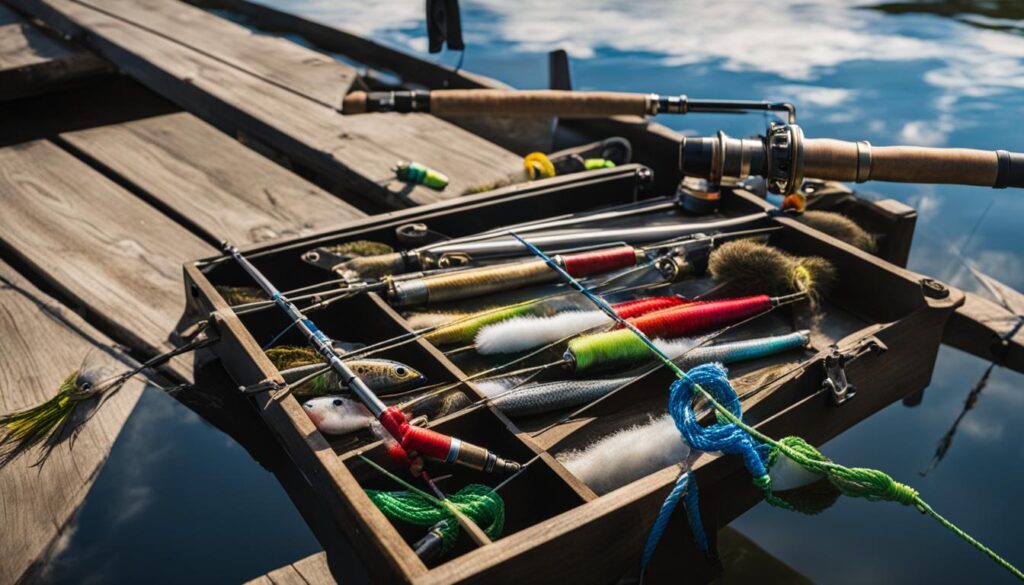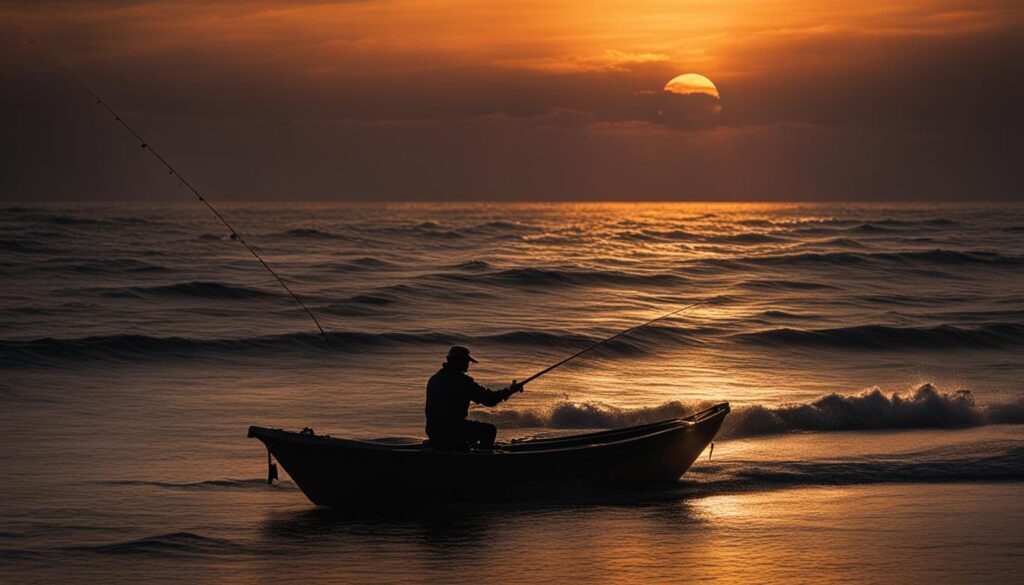We may earn money or products from the companies mentioned in this post.
Are you tired of losing fish due to loose or poorly tied knots? Do you want to improve your angling skills and increase your chances of a successful catch? Then you’ve come to the right place. In this comprehensive guide, we’ll teach you how to master fishing knots and rigs and provide expert tips to enhance your fishing game.
Whether you’re a novice or an experienced angler, learning the art of tying fishing knots is crucial. Not only can it save you time and frustration on the water, but it can also help you catch more fish. By using the appropriate fishing knot and rig for different scenarios and conditions, you can ensure that your lines stay secure and your hooks stay attached.
This article will cover the basics of fishing knots and rigs, diving into step-by-step tutorials on essential fishing knots, exploring various fishing rigs, and discussing advanced techniques for tricky situations. We’ll also provide tips on knot strength, line selection, and troubleshooting knot problems. With this expert guide, you’ll be well equipped to handle any fishing situation that comes your way.
Key Takeaways:
- Mastering fishing knots and rigs is essential for any angler looking to improve their fishing game
- Using the appropriate fishing knot and rig for different scenarios can help you catch more fish
- This article will provide step-by-step tutorials on essential fishing knots, explore various fishing rigs, and discuss advanced techniques for tricky situations
- Optimizing knot strength and choosing the right fishing line is crucial for success
- Troubleshooting knot problems is possible with the expert tips provided in this guide
Understanding Fishing Knots
When it comes to fishing, using the right knot can make all the difference. Different knots serve different purposes, and choosing the best fishing knot for the job can mean the difference between landing a big catch or going home empty-handed.
Learning how to tie fishing knots is crucial for every angler, and with the help of this step-by-step guide, you’ll be able to master some of the best fishing knots out there.
How to Tie Fishing Knots
Before we dive into the best fishing knots, it’s important to understand the basics of knot-tying. Whether you’re a beginner or an experienced angler, learning how to tie fishing knots correctly is crucial.
To tie fishing knots, you’ll need to follow a few general steps:
- Hold your line and create a loop near the end
- Wrap the end of the line around the standing part of the line
- Insert the end of the line back through the loop near the end
- Moisten the knot and tighten it by pulling both ends of the line
Practice makes perfect when it comes to knot-tying, so don’t be afraid to practice your technique until you get it right.
Best Fishing Knots
Now that you have a basic understanding of how to tie fishing knots, it’s time to explore some of the best fishing knots out there. These knots are versatile, reliable, and easy to tie, making them perfect for a variety of fishing situations.
| Knot Name | Use |
|---|---|
| Improved Clinch Knot | Attaching a lure, swivel, or hook to your line |
| Palomar Knot | Attaching a hook to your line for increased strength |
| Loop Knot | Creating a loop at the end of your line for a natural bait presentation |
These knots are just a few examples of the best fishing knots out there. Experiment with different knots to see what works best for you and your fishing style.
By understanding how to tie the best fishing knots and when to use them, you can increase your chances of a successful catch and become a more proficient angler.
Exploring Fishing Rigs
When it comes to fishing, using the right rig can make all the difference. There are many different fishing rigs available, and each has its own unique advantages and applications. Let’s explore some of the most popular fishing rigs and their effectiveness.
The Carolina Rig
The Carolina rig is a widely used and effective rig that is suitable for catching various kinds of fish in both freshwater and saltwater. This popular rig features a sliding sinker, followed by a swivel and a leader with a hook. On the leader, anglers can add soft plastic baits or live bait.
| Advantages | Applications |
|---|---|
| The sliding sinker allows for longer casts and better sensitivity | Works well for catching bass, catfish, and other bottom-feeding fish |
| Great for fishing in murky waters because the bait is elevated off the bottom | Effective in both shallow and deep waters |
The Drop Shot Rig
The Drop Shot rig is another popular rig that is commonly used for finesse fishing. This rig features a hook tied above a sinker, with the weight resting on the bottom and the hook suspended above it. Unlike the Carolina rig, the hook is tied perpendicular to the line.
| Advantages | Applications |
|---|---|
| Allows for precise bait placement and control of the depth | Effective for catching finicky or inactive fish in clear water |
| Great for fishing around structure or cover | Works well with finesse baits such as worms and small minnows |
The Texas Rig
The Texas rig is a classic and versatile rig that works well for a wide range of fishing situations. This rig features a bullet-shaped weight, followed by a swivel and a leader with a hook. Anglers can add soft plastic baits or live bait to the hook.
| Advantages | Applications |
|---|---|
| Great for fishing in heavy cover or around structure | Effective for catching bass, catfish, and other bottom-feeding fish |
| Provides a weedless presentation, reducing the risk of getting snagged | Works well in both shallow and deep waters |
These are just a few examples of popular and effective fishing rigs. By understanding the advantages and applications of each rig, you can choose the right rig for different fishing conditions and increase your chances of catching more fish.
Essential Fishing Knots for Every Angler
Mastering a handful of essential fishing knots is fundamental for any angler. Knowing when to use them, and how to tie them correctly, can increase your chances of a successful catch. In this section, we will provide a step-by-step guide for tying three essential fishing knots: the improved clinch knot, the Palomar knot, and the loop knot.
The Improved Clinch Knot
The improved clinch knot is one of the most widely used knots by anglers. It’s versatile and strong, making it a go-to knot for securing hooks, lures, and swivels to your fishing line.
- Thread the end of your fishing line through the eye of your hook or swivel.
- Twist the end of the line around the mainline five to seven times.
- Insert the tag end (the loose end) of the line through the loop just above the eye of the hook.
- Thread the tag end through the big loop created by the twists and pass it through the small loop created right above the eye of the hook.
- Moisten the knot with saliva or water and pull tight.
The improved clinch knot is a reliable knot that can handle the weight and power of large fish species.
The Palomar Knot
The Palomar knot is a simple and effective knot that can be used to tie your line to your hook, lures, or swivels. It’s known for its strength and reliability, making it a favorite among anglers.
- Fold your fishing line in half and form a small loop.
- Insert the end of your loop through the eye of your hook or swivel.
- Tie a basic overhand knot with the doubled line, but don’t tighten it yet.
- Pass the loop over the hook or swivel and pull it up until it’s snug around the eye.
- Moisten the knot and pull both ends of the line to tighten it.
The Palomar knot is an excellent knot for heavier lines and big fish species.
The Loop Knot
The loop knot, also known as the “perfection loop,” is a versatile knot that can be used to create loops for attaching lures, leaders, or droppers. It’s known for its strength and for allowing a more natural movement of lures in the water.
- Form a small loop in your line by creating a simple overhand knot, but don’t tighten it yet.
- Pass the end of the line through the loop.
- Wrap the end of the line around the doubled line four times.
- Insert the end of the line back through the loop and moisten the knot with saliva or water.
- Slowly pull both ends of the line to tighten it, making sure the coils are packed neatly together.
The loop knot is an essential knot for anglers who want to improve their lure presentation and catch more fish.
Advanced Techniques for Tricky Situations
When it comes to fishing, there are situations where basic knots and rigs may not be enough. In order to target specific species or adapt to unique environments, advanced techniques are necessary. These top fishing knot techniques and effective fishing rigs can help you catch more fish in challenging scenarios.
Double Uni Knot
The Double Uni Knot is a great knot for attaching two lines of different diameters. It is a versatile knot that can handle different types of lines such as mono, braid, and fluorocarbon. With its strong and reliable connection, it is perfect for attaching a leader to a mainline or two lines for a drop shot rig.
| Steps | Instructions |
|---|---|
| Step 1: | Tie a simple overhand knot in one of the lines. Leave enough tag end to work with. |
| Step 2: | Take the other line, and pass it through the loop created by the overhand knot. |
| Step 3: | Wrap the tag end of the second line around the standing part of the first line for 4-6 times. |
| Step 4: | Take the tag end of the second line and pass it back through the loop created by the overhand knot. |
| Step 5: | Wet and tighten the knot by pulling both the standing part and tag end of both lines at the same time. Trim the tag ends. |
Carolina Rig
The Carolina Rig is a great rig for fishing in deep water or when fish are suspended. It consists of a sliding sinker, a swivel, a leader, and a hook. The sliding sinker allows the fish to take the bait without feeling the weight of the sinker. This rig presents the bait in a natural and realistic way and is an effective way to catch bass, catfish, and other types of fish.
To tie the Carolina Rig, start by tying a barrel swivel to the mainline. Then tie a leader to the other end of the swivel and attach a hook to the end of the leader. Slide a weight onto the mainline, followed by a bead and a stopper. The stopper prevents the weight from sliding all the way to the hook. Adjust the length of the leader based on the depth of the water you’re fishing.
Snell Knot
The Snell Knot is a strong knot that is ideal for tying hooks to a leader or a line. It is a popular knot among anglers because it keeps the hook in an upright position, allowing for a better hookset. This knot works well with circle hooks and is great for catching big fish such as tuna, marlin, and sailfish.
| Steps | Instructions |
|---|---|
| Step 1: | Insert the tag end of the line through the eye of the hook and pull it through until you have 6-8 inches of tag end on the other side. |
| Step 2: | Overlap the tag end and the standing part of the line. Hold them together and create a small loop behind the hook. The tag end should be on top of the standing part of the line. |
| Step 3: | Hold the loop and the standing line in one hand and use the other hand to wrap the tag end of the line around the hook and the line. Make 7-10 wraps around the hook and the line. The wraps should be tight and close together. |
| Step 4: | Insert the tag end of the line through the loop created behind the hook and pull it all the way through. Make sure that the tag end comes out on the same side of the hook as the standing part of the line. |
| Step 5: | Wet and tighten the knot by pulling the standing part of the line and the tag end at the same time. Trim the tag end. |
These advanced techniques for tying fishing knots and creating fishing rigs can help you become a more versatile and successful angler. By mastering these top fishing knot techniques and effective fishing rigs, you can adapt to any fishing situation and increase your chances of a great catch.
Tips for Knot Strength and Line Selection
Choosing the right fishing line for your knots is crucial to ensure their strength and effectiveness. Here are some tips to help you optimize your knot strength and select the best fishing line for your needs.
Choose the Right Line Material
The material of your fishing line can have a significant impact on knot strength and overall fishing performance. Monofilament is a popular choice, offering a great balance of strength, sensitivity, and affordability. Braided lines are stronger than monofilament and have a smaller diameter, allowing you to cast further and feel more bites. Fluorocarbon lines are virtually invisible underwater, making them ideal for finicky fish.
Consider Line Diameter
The diameter of your fishing line can also affect knot strength. A thicker line may be more visible to fish and reduce casting distance, but it can also offer more strength and abrasion resistance. Thinner lines have less friction and can help you cast further, but they may not be as durable for heavy-duty fishing.
Match Line Strength to Knot Strength
It’s essential to match the strength of your fishing line to the strength of your knots. If your line is stronger than your knot, the knot is likely to fail under pressure. Conversely, if your knot is stronger than your line, it can cause the line to weaken or break. When selecting line strength, consider the size and species of the fish you’re targeting and the fishing conditions you’ll encounter.
Use Lubrication
Adding lubrication to your knots can help to reduce friction and improve knot strength. You can use saliva, water, or specialized knot lubricants to make your knots smoother and prevent abrasion. Before tightening your knot, wet it with lubrication and pull it tight slowly to ensure a secure hold.
Practice Your Knot-Tying Technique
The key to strong knots is proper technique. Take the time to practice your knot-tying skills regularly and ensure you’re tying each knot correctly. When tying your knots, be sure to tighten each loop and pull all strands evenly to create a strong, secure hold.
Troubleshooting Knot Problems
Despite your best efforts, sometimes fishing knots can present challenges. Whether it’s slipping or breaking, knot problems can be frustrating and cost you the chance to catch a fish. In this section, we will provide you with some troubleshooting techniques to help you overcome common knot problems.
Adjust Your Technique
If you’re having trouble with a particular knot, try adjusting your tying technique. Sometimes, a slight variation in your knot-tying method can make a significant difference in the knot’s strength and reliability. Consider watching knot-tying tutorials or consulting with an experienced angler to learn different techniques.
Use Alternative Knots
If you’re still struggling with a knot, you may want to try using an alternative knot. While some knots are more versatile and reliable than others, certain knots may be better suited for specific fishing scenarios or line types. Experimenting with different knots can also expand your knot-tying skills and give you more versatility as an angler.
Check Your Line and Tackle
Knot problems can sometimes be caused by issues with your fishing line or tackle. Make sure your line is in good condition and free of any abrasions or fraying. Check your hooks, swivels, and other tackle components to make sure they are the appropriate size and strength for the fish you’re trying to catch.
Avoid Over-Tightening
While it’s important to make sure your knots are tight and secure, be careful not to over-tighten them. Over-tightening can weaken the line and cause it to break or slip. Instead, tighten your knots gradually and use a steady, consistent pressure.
Conclusion
In conclusion, mastering fishing knots and rigs is essential for any angler looking to improve their fishing game. As we have shown in this guide, understanding the different knots and rigs can make a huge difference in your angling success. By utilizing the best fishing knots, creating effective fishing rigs, optimizing knot strength, and troubleshooting any issues, you can enhance your angling skills and increase your chances of a successful catch.
Always Learning
Remember, even the most experienced anglers are always learning. Keep practicing and experimenting with different knots and rigs to find what works best for you. Don’t be afraid to ask for advice from more seasoned anglers or seek out additional resources for fishing knot tutorials and fishing rig tutorials.
Happy Fishing
With the expert guide and tips provided in this article, you’re well on your way to becoming a more proficient angler. We hope that you found this guide helpful and informative, and wish you the best of luck on your future fishing endeavors. Happy fishing!
FAQ
Why are fishing knots and rigs important?
Fishing knots and rigs are important because they ensure that your lines stay secure and your hooks stay attached. By using the right knots and rigs for different fishing scenarios, you can increase your chances of a successful catch.
How do I tie fishing knots?
Tying fishing knots involves following step-by-step instructions. There are various types of knots that you can learn, such as the improved clinch knot, the Palomar knot, and the loop knot. By practicing these knots, you can become proficient in tying them.
What are some popular fishing rigs?
Some popular fishing rigs include the Carolina rig, the Texas rig, and the drop shot rig. Each rig has its advantages and applications, and they can be used in different fishing situations to target specific fish species.
Which fishing knots should every angler know?
Every angler should know essential fishing knots such as the improved clinch knot, the Palomar knot, and the loop knot. These knots are versatile and can be used in a variety of fishing scenarios.
Are there advanced techniques for tricky fishing situations?
Yes, there are advanced techniques that can improve your chances of success in tricky fishing situations. These techniques include specialized knot techniques and advanced fishing rigs that are designed for specific fish species or unique fishing environments.
How do I optimize knot strength and choose the right fishing line?
To optimize knot strength, it’s important to select the appropriate line material, diameter, and strength for different fishing applications. Understanding the relationship between knots, lines, and their overall strength will help you avoid lost catches and improve your angling success.
What should I do if I encounter problems with my knots?
If you encounter problems with your knots, such as slipping or breaking, there are troubleshooting techniques you can use. These include adjusting your tying technique or using alternative knots. By addressing these issues, you can overcome knot-related challenges and improve your overall fishing experience.
Affiliate Disclosure: This post may contain affiliate links. If you purchase through our link, we may receive a small commission, but at no additional cost to you. For more information, please see our Disclosure statement.



